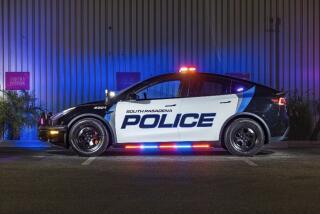LAPD Shows 2 Ways to End Pursuits of Fleeing Cars
- Share via
To hear LAPD officers tell it, it’s like tapping a fleeing suspect on the ankle to trip him. Except these suspects are behind the wheels of 3,500-pound automobiles.
With lights and sirens wailing Wednesday, three patrol cars came barreling down behind a Ford on the track of the LAPD’s $29-million training facility for the unveiling of two crime-fighting techniques newly approved for the force.
The officer in the lead car suddenly pulled alongside the fleeing Ford. He nudged his cruiser’s front side panel against the rear side panel of the faux suspect’s Ford, sending it into a 180-degree spin. The suspect’s car came to a screeching halt and was trapped by two other pursuing cars.
To those in the Ford, it was as if they had hit a patch of ice.
“This is a totally different approach for us,” Chief William J. Bratton said, turning to Mayor James K. Hahn, on hand for the demonstration at the Edward M. Davis EVOC Firearms/Tactics Training Facility in Granada Hills, along with a plethora of onlookers and TV cameras.
The automobile ballet -- known as the pursuit intervention technique, or PIT, maneuver -- is one of two new methods of halting pursuits of fleeing cars that the Police Commission approved for Bratton this week. The policies have been in the planning stage more than a year.
Moments after the PIT spin-out, the second technique was unveiled.
A faux suspect in a gray Ford came bombing around the track. Suddenly, an officer on the curb slung a 9-foot tire-deflation strip across the roadway. The Ford’s tires rolled over the spike strip, also called a stop stick. Tiny spikes -- valve-like quills embedded into the foam strip -- stuck into the tires’ rubber, gradually releasing the air so the car ground to a halt. The sticks are a one-shot deal.
“It is our intention to try to the best of our ability when possible to end pursuits earlier and more safely, reducing the amount of time and the risk to the public, our officers, as well as those being pursued,” Bratton said. About 400 LAPD officers have spun their way through training, and all 3,000 patrol officers should be up to snuff by summer’s end, Bratton said.
These tools aren’t new to Southland streets. The California Highway Patrol has been spinning cars and dropping spike strips since the early 1990s.
The PIT maneuver was created by BSR Inc., an advanced driving training school in Summit Point, W.Va., for Navy SEALs. It was popularized by the CHP and Virginia agencies.
The spike strip weighs a little more than a pound and can be thrown up to 80 feet by an officer, LAPD Sgt. Ron Moen said. The strip can be used on vehicles traveling up to 65 mph, he said.
Although the strip itself is unlikely to cause crashes, in at least two incidents involving the CHP a vehicle loaded with illegal immigrants fleeing across the border swerved to avoid the strip and rolled over.
“The PIT maneuver, if done properly, is the most effective and non-evasive way to end a chase,” said Geoffrey P. Alpert, chairman of the University of South Carolina’s department of criminology and criminal justice. “It is a phenomenal tool if done well. But like any tool and tactic, it can be abused.”
In a few cases, the PIT has come under fire. Seattle police are generally discouraged from using the maneuver in dense urban settings. And in Georgia, a 21-year-old woman and 17-year-old boy were killed last year when a state trooper used the maneuver on their SUV after a high-speed chase. The incident has led some to question the safety of the technique on SUVs.
Moen said the maneuver was designed to be used when speeds were less than 35 mph, when no pedestrians or other cars were in the area, and when the roadway was relatively wide. Both the PIT and tire-deflation devices can be used only when officers believe that the fleeing motorist is placing people in imminent danger.
In the LAPD, a watch commander or sergeant overseeing the chase will make the call when to use the maneuver.
Moen said that unlike the case in many smaller departments, helicopter observers would also tip those on the ground to an ideal place to use the PIT. But don’t expect to see it during rush hour, he said.
Another limitation is that the fleeing vehicle can’t be bigger than the cruiser. Nor will suspects armed with firearms be spun. When the maneuver is properly executed, Moen said, the patrol car should be undamaged.
Bratton said he believed the training would ensure officer and public safety. “It is our position we can do the PIT maneuver safely,” he said.
More to Read
Sign up for Essential California
The most important California stories and recommendations in your inbox every morning.
You may occasionally receive promotional content from the Los Angeles Times.










